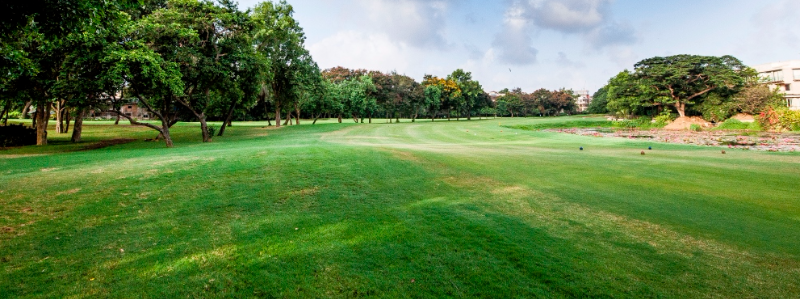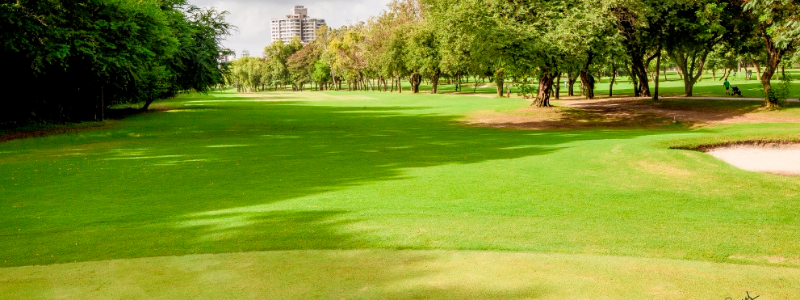Golf Course Details
Description :
| Year built : | 1927 |
| Designer : | Peter Thompson |
| Redesigner : | Redesigned in 2007 by Nelson Haworth |
| Holes/yardage/par : | 18 holes, 6148 yards,Par 70 |
| Altitude (MSL) : | 25 feet |
| Course Record : | 63 |
| Record Holder : | Gurbaaz Mann |
| Record Date : | 05/05/2010 |
| Weekly Holiday : | Monday |
| Longest hole : | Hole 4, 508 yards, Par 5 |
| Shortest hole : | Hole 10, 140 yards, Par 3 |
| Toughest hole : | Hole 4, 508 yards, Par 5 |
| Course/slope rating : | 68.90 /123 (Gold) |
| 68.10 / 121 (Blue) | |
| 65.60 / 115 (White) | |
| 70.0 / 121 (Red) |
Local Rules :
BPGC LOCAL RULES
1. Out of bounds (rule 27). A ball is deemed to be “out of bounds” if it lies on or beyond the perimeter fence/wall or white stakes joined by white lines. A ball is out of bounds when all of it lies out of bounds.
Boundaries - of the course are defined by wire fence, concrete wall, white stakes etc., and the out of bound line is determined by the nearest inside points at the ground level of concrete pillars/posts or stakes.
- Beyond the white stakes to the right of 3rd, 12th, & 15th fairway.
- Beyond the inside wall boarding the drain (nullah) to the right of 11th fairway, beginning from behind the 14th green, including the slab.
Note: A ball coming to rest within the course but beyond the public road between holes no 15th & 16th shall be deemed “out of bounds ".
2. Water hazards - Hazards on the course are defined by yellow stakes /or lines and lateral water hazards (LWH) are defined by red stakes /or lines. A ball in or lost in hazard/lateral water may be played in accordance with rules 26-1 and 26-2.
3. Ground under repair (rule 25-1)
- All areas freshly marked with white paint and or lime powder.
- Protection of young trees - play prohibited : If such a tree marked with fresh white paint or white stakes interferes with the player's stance or swing the player must take relief under rule 24-2b.
- Relief permitted only for a ball lying in deep vehicle ruts / tyre marks. Relief denied for stance or swing
4. Embedded ball - A ball embedded in its own pitch mark through the green may be lifted, cleaned and dropped, without penalty, as near as possible to the spot where it lay but not nearer the green.
5. Obstructions:
A) Movable obstructions - rule 24-1
- Stones in the bunker.
- Stakes identifying hazards.
- Distance markers.
B) Immovable obstructions - rule 24-2
All manmade/artificial objects including irrigation panels, sprinkler heads, light poles, artificial paved surfaces etc., unless stated otherwise. A player may obtain relief from interference, as defined in rule 24-2a from the following in the manner prescribed under rule 24-2b.
C) If a ball lies off the putting green but not in a hazard and an immovable obstruction is within two club-lengths of the putting green and the ball lies within two club lengths of the immovable obstruction, the player may take relief as follows: the ball must be line of play between the ball the hole, the player may take relief as follows: the ball must be lifted and dropped at the nearest point to where the ball lay that (a) is not nearer the hole, (b) avoids intervention and ( c ) is not in a hazard or on a putting green . The ball may be cleaned when lifted.
6. Integral parts of the course
- Pipes / cables attached to the boundary wall.
- Midway hut near the 6th & 15th tee.
- All screen fences, netting etc., protecting tees / practice tees.
- Poles attached with netting.
7. Permanent elevated cables - a ball striking an elevated power cable / wire must be replayed without penalty (rule 20-5). If the ball is not immediately recoverable another ball may be substituted.
Note: When it is virtually certain that the ball has struck any electrical unit (light / telegraph pole or tower) or cable rising from the ground level must be replayed.
8. Distance-measuring device - For all play at this course, a player may obtain distance information by use of a distance-measuring device. If, during a stipulated round, a player uses a distance-measuring device to gauge or measure other conditions that might affect his play (e.g., elevation changes, wind speed, etc.), the player is in breach of Rule 14-3."
9. Accidental Movement of a Ball on a Putting Green
Rules 18-2, 18-3 and 20-1 are modified as follows:
When a player’s ball lies on the putting green, there is no penalty if the ball or ball-marker is accidentally moved by the player, his partner, his opponent, or any of their caddies or equipment.
The moved ball or ball-marker must be replaced as provided in Rules 18-2, 18-3 and 20-1.
This applies only when the player’s ball or ball-marker lies on the putting green and any movement is accidental.
Note: If it is determined that a player’s ball on the putting green was moved as a result of wind, water or some other natural cause such as the effects of gravity, the ball must be played as it lies from its new location. A ball-marker moved in such circumstances is replaced.”
10. All the distance markers painted on the fairway are to be treated as GUR.
11. The drop zones are provided behind 3, 7, 11, 14 & 16 greens for ball unplayable under one stroke penalty (Rule 28)
12. The drop zone behind the green 12 is provided for ball unplayable under one stroke penalty. Rule 28 and water hazard rule 26. (For the lateral hazard behind the green)
GolfRound1
| TEE | Course Rating | Slope Rating |
|---|







